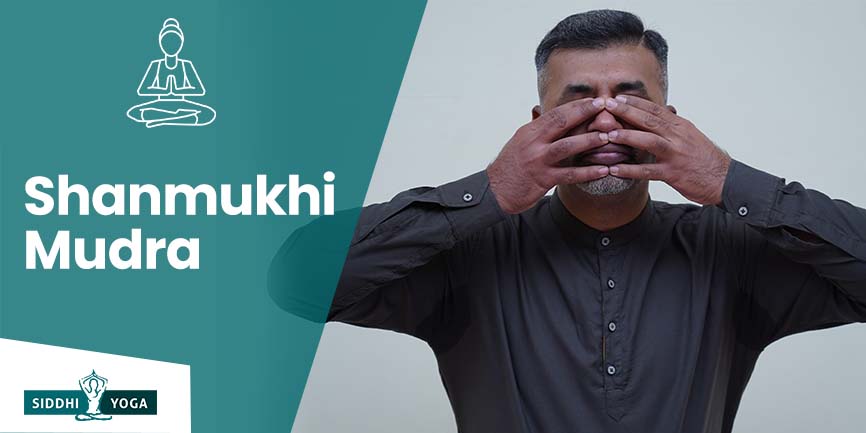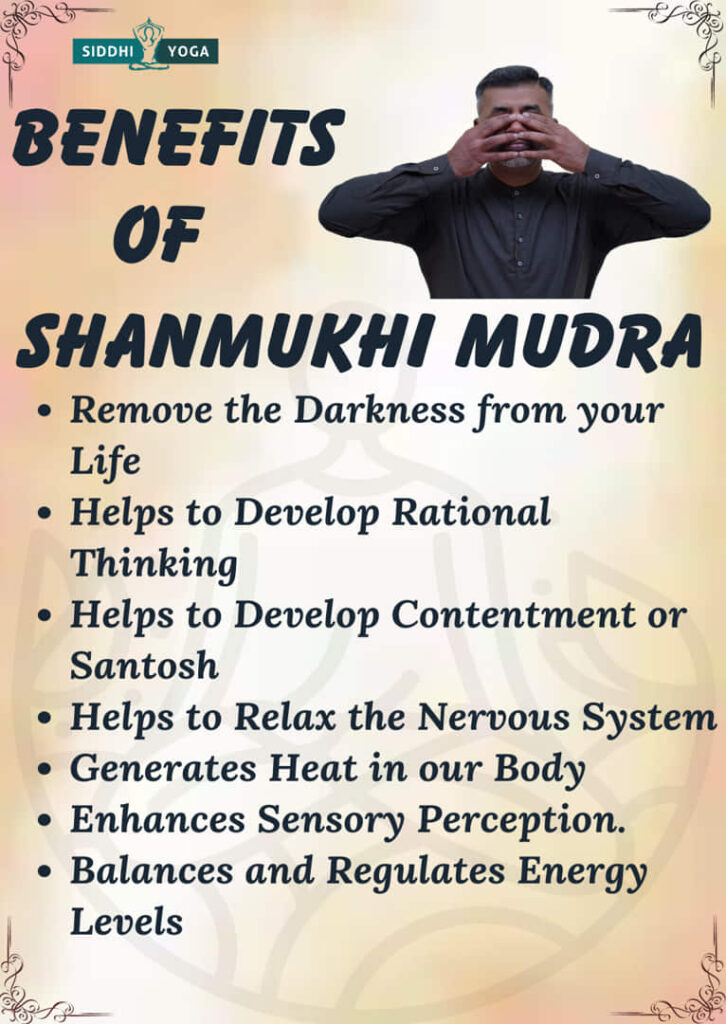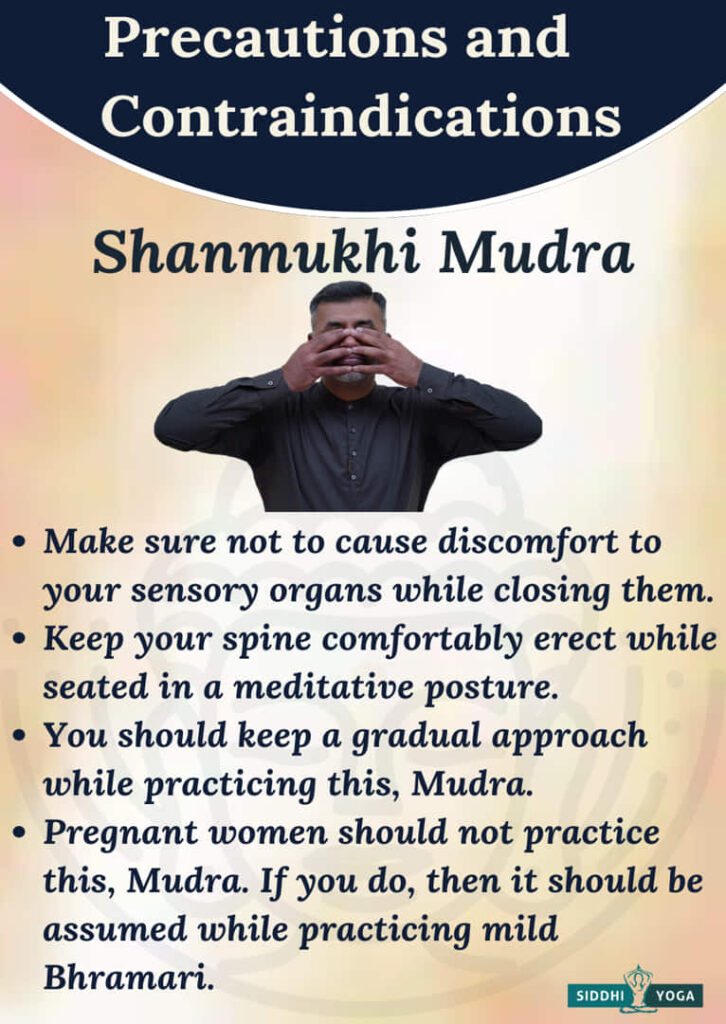
The Shanmukhi Mudra is a powerful hand gesture. Discover the meaning and benefits of the Shanmukhi mudra and learn how to do this mudra.
Definition – What is Shanmukhi Mudra and its Meaning, References, and Mythology?
Shanmukhi Mudra is a Hasta Mudra or Yogic hand gesture/seal. To simplify the meaning of this Mudra, we will break it down into simple words.
The word Shanmukhi Mudra is made of two different words.
The word Shanmukhi can be further divided into two parts: Shan+Mukhi
Shan – The word means “seven.”
Mukhi – This word represents “faces” or “gate.”
Mudra – the word “Mudra” is used to describe Hand gestures or seals.
This Mudra is also known as Baddha yoni asana, the locked source pose, Devi Mudra, etc.
This Mudra follows the Pratyahara’s rule as prescribed by the Maharshi Patanjali. Pratyahara can be defined as the withdrawal of senses from their food. According to Maharshi Patanjali, Pratyahara is the 5th limb of his Ashtanga Yoga or eight-limb Yoga.
In Shanmukhi Mudra, we close the seven gates so that we can withdraw from our sensory organs.
These are 2 Nostrils, 1 Mouth, 2 Ears, and 2 Eyes.
Nose – To block the smell,
Mouth to block taste and touch,
Ears to block hearing,
and the Eyes to block sight.
While practicing Shanmukhi Mudra, we close or block these sensory organs from taking their food. While practicing this Mudra, we close all these organs and withdraw our senses.
We generally perform the Shanmukhi Mudra while seated in a comfortable meditative pose or lying down in Shavasana.
To maximize the benefits of this Mudra, you can practice it with different Pranayama and Meditation techniques. This Mudra is often assumed while practicing Bhamri Pranayama or humming bee Pranayama. This helps to calm the mind and help us see this world more rationally rather than seeing how our senses perceive it. After practicing this Mudra, you can develop clarity about things you should seek rather than chase after the materialistic things in your life. This brings happiness and prosperity into life.
Alternate Names of Shanmukhi Mudra
Baddha yoni asana, the locked source pose; Devi Mudra.
How to Do Shanmukhi Mudra?
- This Mudra practice requires you to perform in any seated meditative posture because this Mudra practice requires you to block all the sensory organs from taking their food. You might lose your balance if you practice it in a standing posture.
- So, you can sit in any comfortable meditative posture, such as Sukhasana (Cross-legged Pose) or Vajrasana (Thunderbolt Pose).
- Make sure to keep your neck and spine comfortably erect.
- Rest both of your palms comfortably on your knees.
- Gently close your eyes.
- Now, slowly brings your hands close to your face.
- Then, gently close your ears with your thumbs.
- Now, gently place your index fingers on your eyes, your middle fingers on your nostrils, your ring fingers slightly above your lips, and little fingers below your lips. This way, you are going to block all of your senses.
- Release the middle fingers, take a deep inhalation, and practice the Yogic breath. Then, close the nostrils with your middle fingers and retain your breath as long as possible.
- When you can no longer hold your breath, release the middle fingers and exhale slowly.
- Inhale deeply and exhale slowly. With every passing breath, make your breathing even deeper.
- Witness your entire mind and body.
- Make sure to repeat this throughout the entire practice.
Shanmukhi Mudra Benefits

- Shanmukhi Mudra is great if you plan to concentrate or meditate for a long time. It helps you to prepare to achieve more from your practices.
- It helps to remove the darkness from your life.
- This Mudra helps to develop rational thinking. You no longer chase materialistic things in your life.
- This helps to develop Contentment or Santosh, which is a part of Niyama.
- Maharshi Patanjali prescribed Pratyahara, withdrawal of senses, in his Eightfold Yoga. This Mudra helps to achieve that state where you can withdraw all of your senses. As per Maharshi, only if you have achieved Pratyahara, then you should practice Dharna (concentration, Dhyana, and Samadhi).
- It helps to relax the Nervous System.
- It generates heat in our body.
Shanmukhi Mudra Precautions and Contraindications

Similar to all other Mudra practices, it has no side effects.
However, there are a few things to consider.
- Make sure not to cause discomfort to your sensory organs while closing them.
- Keep your spine comfortably erect while seated in a meditative posture.
- You should keep a gradual approach while practicing this Mudra.
- Pregnant women should not practice this Mudra. If you do, then it should be assumed while practicing mild Bhramari.
- People with respiratory conditions, hypertension, and those who have been recently operated on should refrain from practicing this.
When and how long to do Shanmukhi Mudra?
- This Mudra can be practiced when you need to internalize your senses.
- You can practice this when you need to remove all the stressors around you.
- If you want to awaken the serpent power (Kundalini Shakti Jagran) within you.
- If you want to implement practice and detachment as described by various Yogic texts to achieve a state of bliss.
Morning is the ideal time to do any yoga or Mudra. Our brain is at its best in the morning and during the daytime. So, you are more likely to be able to concentrate easily. Therefore, you should practice this Mudra from 4 am and 6 am to get the most effective outcomes.
If you are having difficulty with this during the morning, you can do this Mudra later in the evening too.
Practicing this Mudra for a minimum of 10-20 minutes daily is recommended. Whether you wish to complete it in one stretch or two threes that last between 5 and 10 minutes, it’s up to you. Based on research, the best way to practice an exercise for at least 20 minutes is to get the best benefits of that particular Mudra.
Breathing in Shanmukhi Mudra
There are different types of breathing techniques we can practice with this Mudra:
- We can practice Nadi Sodhan Pranayama to get better at breath retention.
- We can assume this Mudra while practicing Bhramari Pranayam.
Affirmation in Shanmukhi Mudra
While practicing this, Keep a positive intention. Start with:
“I am not bound by my senses. I see things as they are. I see people as they are without any judgment.”
Conclusion
The Shanmukhi Mudra is one of the most popular mudras and has many benefits. If you are interested in learning more about other mudras, consider taking our Mudras Certification Course. This course includes all 108 mudras so you can learn about their history, benefits, and proper techniques for practice. This course is perfect for yoga teachers, healthcare practitioners, and anyone who wants to improve their health and well-being. Sign up today to get started on your journey to better health.